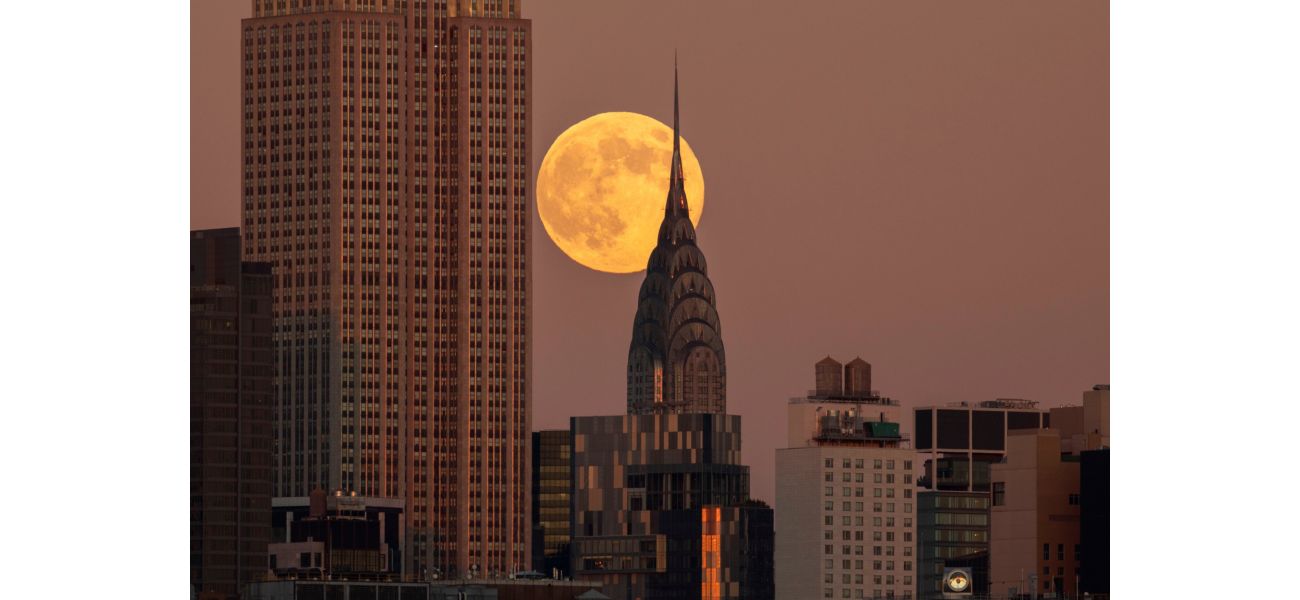The final supermoon of 2024 has passed, but another one is on the horizon.
2024 had four supermoons.
November 16th 2024.

The stunning sight of the Beaver Moon graced the sky over the iconic Chrysler Building, capturing the attention of many onlookers. This supermoon, hailed as the "largest and brightest" of the year, has now passed, but fear not, for there will be another one soon.
For those who may not be familiar, a supermoon occurs when a full moon coincides with its closest point to Earth in its orbit, resulting in a magnificent and imposing spectacle in our night sky. On Friday night, we were fortunate enough to witness the Beaver Moon, named after the diligent beavers who are known to build dams during this time of year. People marveled at the sight of this phenomenon, which could be seen illuminating the sky above famous landmarks like the Chrysler Building in New York and the launchpad of SpaceX's next-generation Starship spacecraft.
This was the fourth supermoon of 2024, following the Sturgeon Moon in August, Harvest Moon in September, and October's Hunter's Moon. But if you happened to miss them all, don't fret, because there will be another one in March, just a few months away. Speaking of SpaceX's Starship spacecraft, it was seen preparing for takeoff under the mesmerizing glow of the Beaver Moon, adding to the already captivating scene.
Now, you may be wondering, when exactly can we expect the next supermoon? Well, mark your calendars because it will grace our skies on March 29, 2025. But before that, there will be more full moons to enjoy, including the "Cold Moon" on December 15, which will reach its peak at 4:02 am. Although it may not be as big as the supermoon, it's still a sight worth seeing.
Before we dive into the details, let's clarify what exactly a supermoon and a full moon are. A supermoon is a term coined by astrologer Richard Nolle in 1979, referring to either a new or full moon that occurs when the moon is within 90% of its closest approach to Earth. This is a result of the moon's elliptical orbit, which means that its path around the Earth is not a perfect circle. As a result, the moon can sometimes be closer to our planet than other times during its cycle.
On the other hand, a full moon is when the entire moon is illuminated by the sun, giving it a breathtaking glow. And when the moon happens to be at its closest point to Earth during a full moon, that's when we witness a "supermoon." During this time, the moon can appear about 10% larger in size, making it a must-see event for many.
As we wait for the next supermoon in March, let's appreciate the beauty of these celestial events and take a moment to look up at the sky, for it never fails to leave us in awe.
For those who may not be familiar, a supermoon occurs when a full moon coincides with its closest point to Earth in its orbit, resulting in a magnificent and imposing spectacle in our night sky. On Friday night, we were fortunate enough to witness the Beaver Moon, named after the diligent beavers who are known to build dams during this time of year. People marveled at the sight of this phenomenon, which could be seen illuminating the sky above famous landmarks like the Chrysler Building in New York and the launchpad of SpaceX's next-generation Starship spacecraft.
This was the fourth supermoon of 2024, following the Sturgeon Moon in August, Harvest Moon in September, and October's Hunter's Moon. But if you happened to miss them all, don't fret, because there will be another one in March, just a few months away. Speaking of SpaceX's Starship spacecraft, it was seen preparing for takeoff under the mesmerizing glow of the Beaver Moon, adding to the already captivating scene.
Now, you may be wondering, when exactly can we expect the next supermoon? Well, mark your calendars because it will grace our skies on March 29, 2025. But before that, there will be more full moons to enjoy, including the "Cold Moon" on December 15, which will reach its peak at 4:02 am. Although it may not be as big as the supermoon, it's still a sight worth seeing.
Before we dive into the details, let's clarify what exactly a supermoon and a full moon are. A supermoon is a term coined by astrologer Richard Nolle in 1979, referring to either a new or full moon that occurs when the moon is within 90% of its closest approach to Earth. This is a result of the moon's elliptical orbit, which means that its path around the Earth is not a perfect circle. As a result, the moon can sometimes be closer to our planet than other times during its cycle.
On the other hand, a full moon is when the entire moon is illuminated by the sun, giving it a breathtaking glow. And when the moon happens to be at its closest point to Earth during a full moon, that's when we witness a "supermoon." During this time, the moon can appear about 10% larger in size, making it a must-see event for many.
As we wait for the next supermoon in March, let's appreciate the beauty of these celestial events and take a moment to look up at the sky, for it never fails to leave us in awe.
[This article has been trending online recently and has been generated with AI. Your feed is customized.]
[Generative AI is experimental.]
0
0
Submit Comment





